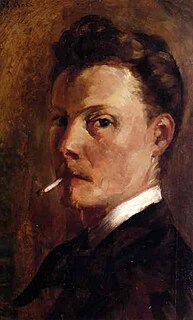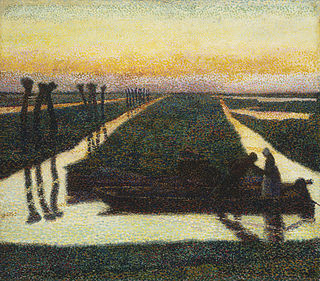
Camille Pissarro was a Danish-French Impressionist and Neo-Impressionist painter born on the island of St Thomas. His importance resides in his contributions to both Impressionism and Post-Impressionism. Pissarro studied from great forerunners, including Gustave Courbet and Jean-Baptiste-Camille Corot. He later studied and worked alongside Georges Seurat and Paul Signac when he took on the Neo-Impressionist style at the age of 54.

Georges Pierre Seurat was a French post-Impressionist artist. He devised the painting techniques known as chromoluminarism and pointillism and used conté crayon for drawings on paper with a rough surface.

Post-Impressionism was a predominantly French art movement that developed roughly between 1886 and 1905, from the last Impressionist exhibition to the birth of Fauvism. Post-Impressionism emerged as a reaction against Impressionists' concern for the naturalistic depiction of light and colour. Its broad emphasis on abstract qualities or symbolic content means Post-Impressionism encompasses Les Nabis, Neo-Impressionism, Symbolism, Cloisonnism, Pont-Aven School, as well as Synthetism, along with some later Impressionists' work. The movement's principal artists were Paul Cézanne, Paul Gauguin, Vincent van Gogh and Georges Seurat.

Pointillism is a technique of painting in which small, distinct dots of color are applied in patterns to form an image.

Paul Victor Jules Signac was a French Neo-Impressionist painter who, working with Georges Seurat, helped develop the Pointillist style.

Henri-Edmond Cross, born Henri-Edmond-Joseph Delacroix, was a French painter and printmaker. He is most acclaimed as a master of Neo-Impressionism and he played an important role in shaping the second phase of that movement. He was a significant influence on Henri Matisse and many other artists. His work was instrumental in the development of Fauvism.

A Sunday Afternoon on the Island of La Grande Jatte was painted from 1884 to 1886 and is Georges Seurat's most famous work. A leading example of pointillist technique, executed on a large canvas, it is a founding work of the neo-impressionist movement. Seurat's composition includes a number of Parisians at a park on the banks of the River Seine. It is in the collection of the Art Institute of Chicago.

Neo-Impressionism is a term coined by French art critic Félix Fénéon in 1886 to describe an art movement founded by Georges Seurat. Seurat's most renowned masterpiece, A Sunday Afternoon on the Island of La Grande Jatte, marked the beginning of this movement when it first made its appearance at an exhibition of the Société des Artistes Indépendants in Paris. Around this time, the peak of France's modern era emerged and many painters were in search of new methods. Followers of Neo-Impressionism, in particular, were drawn to modern urban scenes as well as landscapes and seashores. Science-based interpretation of lines and colors influenced Neo-Impressionists' characterization of their own contemporary art. The Pointillist and Divisionist techniques are often mentioned in this context, because they were the dominant techniques in the beginning of the Neo-impressionist movement.

Albert Dubois-Pillet was a French Neo-impressionist painter and a career army officer. He was instrumental in the founding of the Société des Artistes Indépendants, and was one of the first artists to embrace Pointillism.

Divisionism, also called chromoluminarism, was the characteristic style in Neo-Impressionist painting defined by the separation of colors into individual dots or patches which interacted optically.

Lucien Pissarro was a landscape painter, printmaker, wood engraver and designer and printer of fine books. His landscape paintings employ techniques of Impressionism and Neo-Impressionism, but he also exhibited with Les XX. Apart from his landscapes he painted a few still lifes and family portraits. Until 1890 he worked in France, but thereafter was based in Britain.

Blanche Hoschedé Monet was a French painter who was both the stepdaughter and the daughter-in-law of Claude Monet.

The Channel of Gravelines, Petit Fort Philippe is a pointillist painting by French artist Georges Seurat, located in the Indianapolis Museum of Art in Indianapolis, Indiana. Painted in 1890, the year before his death, it depicts a harbor in the small French port of Gravelines. Described as "wistful and poetic," it is one of the treasures of the IMA.

Broek in Waterland is an 1889 oil painting by Dutch-Indonesian artist Jan Toorop, located in the Indianapolis Museum of Art in Indianapolis, Indiana. It is a pointillist image of the Dutch village of Broek in Waterland at twilight.

The Banks of the Oise near Pontoise is an 1873 oil painting by French artist Camille Pissarro, located in the Indianapolis Museum of Art, which is in Indianapolis, Indiana. It depicts the river Oise near the market town of Pontoise.

The Lagoon of Saint Mark, Venice is an oil on canvas painting by Paul Signac. This painting focuses on a seascape image which became a common theme late in Signac's life.

Afternoon Tea is a 1910 oil painting by American artist Richard E. Miller, located in the Indianapolis Museum of Art, which is in Indianapolis, Indiana. Like many of Miller's paintings, it depicts women in a sunny scene, filled with flowers, depicted in his Impressionist style with a distinct flavor of Japonism.

Le Chahut is a Neo-Impressionist painting by Georges Seurat, dated 1889–90. It was first exhibited at the 1890 Salon de la Société des Artistes Indépendants in Paris. Chahut became a target of art critics, and was widely discussed among Symbolist critics.

Paul-Émile Pissarro, also Paulémile Pissarro or Paul Émile Pissarro was a French impressionist and neo-impressionist painter. He came from the Pissarro family of artists.



















